Western Digital Expands HGST Helium Drive Lineup with 10TB Ultrastar He10
by Ganesh T S on December 2, 2015 3:01 AM EST- Posted in
- Enterprise
- Storage
- HDDs
- Western Digital
- HGST
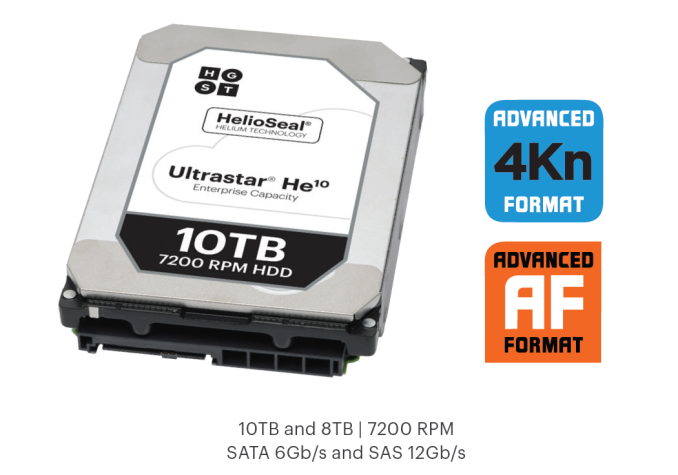
HGST, a Western Digital subsidiary, has been shipping hard drives sealed with helium for a couple of years now. Their helium drives have so far come in two flavors - the Ultrastar He drives using platters with traditional perpendicular magnetic recording (PMR) technology and the Ultrastar Archive Ha drives using platters with shingled magnetic recording (SMR). There are two main patented innovations behind the helium drives, HelioSeal and 7Stac. The former refers to placement of the platters in a hermetically sealed enclosure filled with helium instead of air. The latter refers to packaging of seven platters in the same 1" high form factor of traditional 3.5" drives.
The Ultrastar He6 6TB drive was introduced in November 2013, and this was followed by the He8 8TB drive late last year. In June 2015, the Ultrastar Ha10 SMR drive with HelioSeal technology was introduced. Around the same time, HGST also made it known that more than 1M HelioSeal units had been deployed. 1.33 TB platters have become available in air drives now, and HGST is taking advantage of that in the 10TB Ultrastar He10. The launch of the Ultrastar He10 PMR drive today also brings the news that more than 4M HelioSeal units have been deployed in various datacenters - pointing to the rapid rise in adoption rate of this technology.
We have already seen in our reviews that the helium drives offer the best performance to power ratio and watts per TB metric amongst all the drives in their capacity class. HGST also claim a 2.5M hour MTBF - much higher than traditional enterprise PMR drives. The initial cost of the helium drives have been substantially higher compared to the standard drives of the same capacity, but the TCO (total cost of ownership) metric is highly in favor of these drives - particularly for datacenter customers who need the drives to be active 24x7. HGST's press briefing included a slide that presented the potential TCO benefits that come about due to the increased capacity per rack, lower consumption per rack and lower power consumption per TB of the new He10 drives.
HGST indicated that the ramp in volume should help the initial cost to approach that of the air drives in the near future. For datacenter customers, that would mean an acceleration in obtaining the TCO benefits.
Coming to the core specifications, the Ultrastar He10 will come in both SATA 6Gbps and SAS 12Gbps varieties. The drives have 4KB sectors, though SKUs with 512-byte emulation are also available. Various data security options such as instant secure erase, self-encryption, secure erase and TCG encryption with FIPS are available.
The standard Ultrastar He drive features such as rotational vibration safeguard (for better RV tolerance in multi-drive servers) and the rebuild assist mode (for faster RAID rebuild) are retained. The drives come with a 256MB DRAM buffer.
Hard drives are struggling to reach the 10TB capacity point with traditional PMR technology. While Seagate did announce a few 8TB PMR drives earlier this quarter, it really looks like vendors need to move to some other technology (shingled magnetic recording or heat-assisted magnetic recording (HAMR)) in order to keep the $/TB metric competitive against the upcoming high-capacity SSDs. As of now, helium seems to be the only proven solution causing minimal performance impact and HGST appears to have a strong hold in this particular market segment.


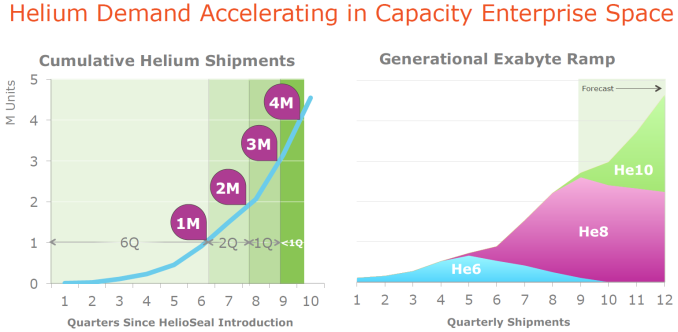
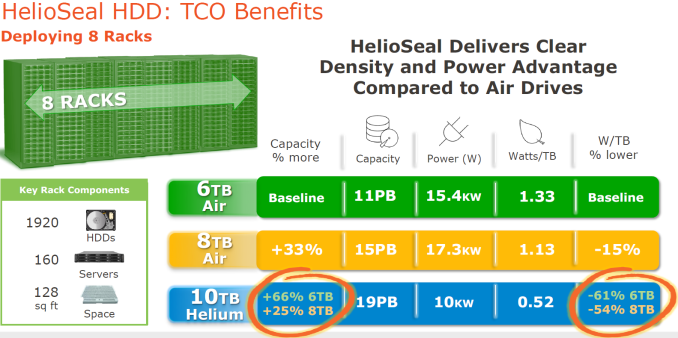
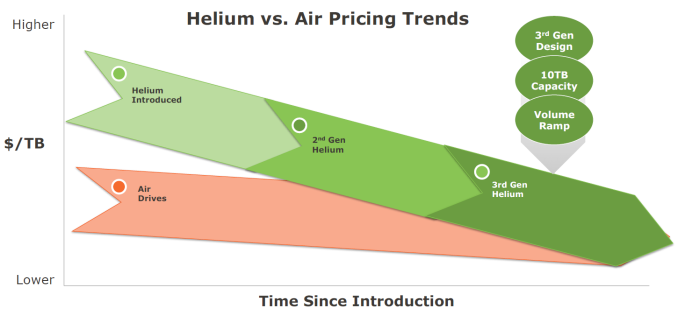
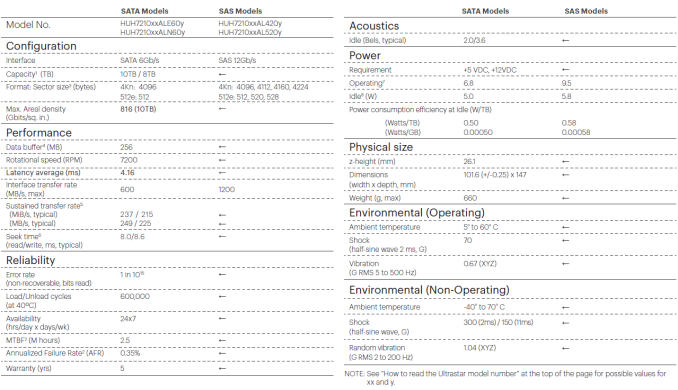
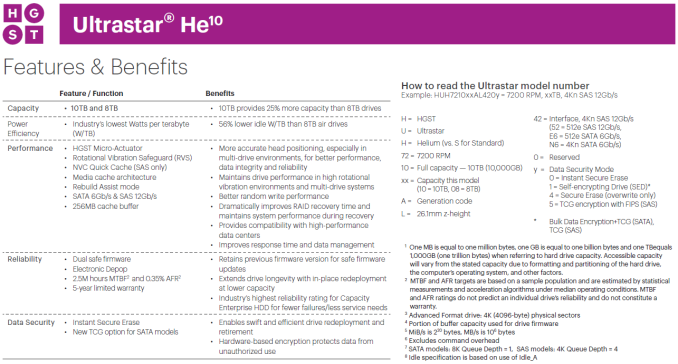








113 Comments
View All Comments
ats - Wednesday, December 2, 2015 - link
They had multiple heads, those failed. The mechanics of multiple heads are such that it is almost as cheap to buy 2 drives than 1 drive with 2 sets of heads. And having all the heads independent costs even more and presents massive mechanical issues.kb9fcc - Wednesday, December 2, 2015 - link
Agreed, the problems with larger platters are mechanical and electrical, not electronic. Larger platters also require much more power to get spun up and maintain that rpm. More power means more heat. Both are "bad" in the long run. Larger platters also mean that the heads will need to move farther to cover the platter, which means longer actuator arms, which mean more mass. More mass, more power to move. F=ma. And slower. as it's going to a lot more power to stop the head at the desired point on the disk, or settle times will just be that much longer. Lose-lose.Now, I could get behind a SSD in a 5.25 form factor to allow space for more memory in the case. However, that is such a niche market as to be not be viable. But it might be a way to dump previous gen flash in higher capacity drives while current/next gen flash bump on die capacity and go to smaller form factors.
extide - Wednesday, December 2, 2015 - link
Problem with larger form factor SSD's is the cost of the flash.Samsung already fits 2TB into a 7mm tall 2.5" drive, and it costs $800+ If you moved even to a 3.5" drive, so you could fit even more flash, it would be getting into the $2000 range! In the consumer market there is very little room for even an $800 SSD, much less ones significantly more expensive. What about enterprize, you say? Well, they are moving towards all PCIe flash, and there are already options out there with multiple terrabytes (3-4+) costing several thousands of dollars.We will probably never see SSD's larger than 2.5" -- at least ones that are larger, in order to hold more flash. I think OCZ made some 3.5" ssd's a long time ago, but they were nothing more than the guts of a 2.5" drive in a bigger case. Pointless.
smartthanyou - Wednesday, December 2, 2015 - link
"Lots of speculation, no facts, just a load of "probably" without argumentation." – ddriver, I am confused. Are you talking about your first post or shodanshok's. The statement seems to apply to both equally.ddriver - Wednesday, December 2, 2015 - link
The context is quite clear, if you really don't get it, you are definitely not as smart as you think you are.The arguments presented by shodanshok don't apply, the product he claims to be proof of failure has nothing to do with the product I speak of.
I never used "probably" - the tech I speak of will work, it is sound and mature tech, it just has never been applied on such a scale due to corporate politics. shodanshok didn't provide a valid reason why it shouldn't work, thus his opinion is speculations based on his misconception.
extide - Wednesday, December 2, 2015 - link
Lol man, you are in a dream world..ddriver - Wednesday, December 2, 2015 - link
Nah, I just know what is technically possible and have higher standards of expectations, which I agree is atypical in a world, mostly inhabited by consumer hoes whose "demands" are dictated by the industry. It is you who is a hopeless dreamer if you believe you are making any sort of point with such posts.DCide - Wednesday, December 2, 2015 - link
I suspect that ddriver (Discussion Driver?) is better at positing almost-good-sounding arguments than being right.MrSpadge - Wednesday, December 2, 2015 - link
A typical 1/2 platter 500 GB desktop drive used to cost less than 10€ to build a few years ago (price from OEM including VAT 17€ around 2011, before the flood). Adding platter doesn't make things significantly more expensive, but all the things you are asking for do. They'd rather procude more standard drives and let you plug several of them into one 5.25" slot.That they're charging 100's of $/€ for the bigger drives is an entirely different question - it's not only the production cost. If they stopped R&D they could probably sell the biggest drives for 50$ and still refinance the factory. But not much else.
ats - Wednesday, December 2, 2015 - link
ZERO speculation. Lots of actual facts. 5.25" drives would have lower MTBF, lower vibration tolerance, lower RPM, much worse seek performance, much lower random performance, and at best the same sequential performance.Anyone familiar with the history of magnetic media will readily agree as would anyone within the industry.
Larger platters mean more vibration issues, longer armatures, all requiring greater spacing. Longer armatures also mean less precision, resulting in greater alignment issues for tracks, more mass, resulting in slower seaking, etc. There is a reason that 15k RPM drives use a fraction of the available area for actual recording.
Or there is the simple fact that NO ONE CARES ABOUT SEQUENTIAL SPEEDS! NO ONE. NOT A SINGLE PERSON. The limit is never sequential performance and 5.25" doesn't have the possibility of helping with anything else.